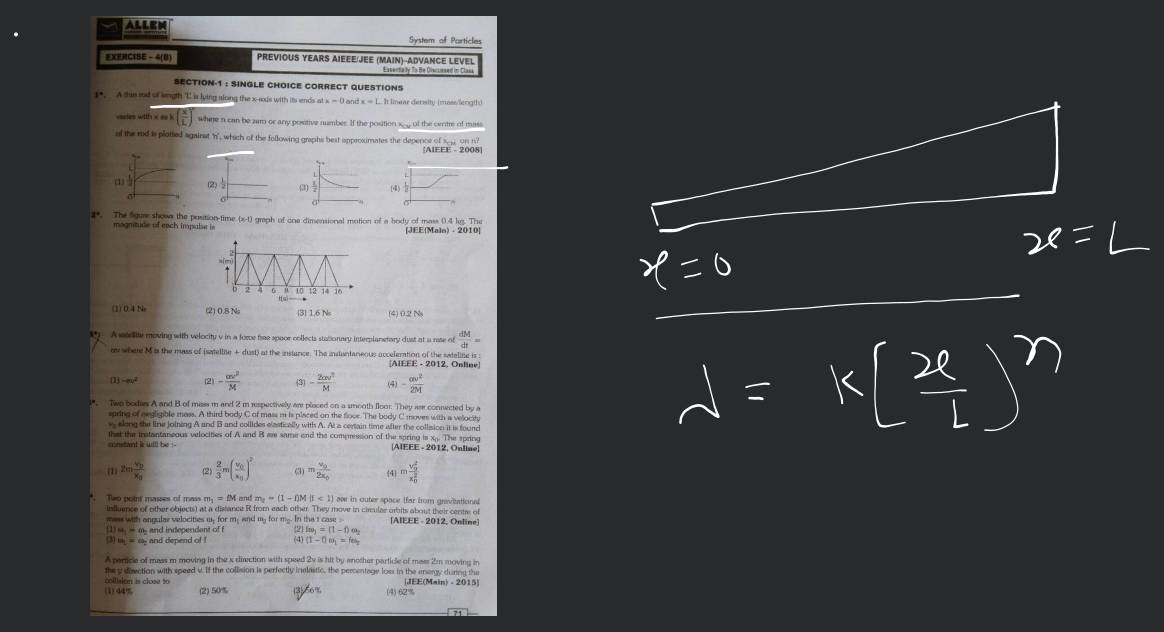Question
Medium
Solving time: 3 mins
A particle of mass moving in the -direction with speed is hit by another particle of mass moving in the -direction with speed . If the collision is perfectly inelastic, the percentage loss in the energy during the collision is close to
(a)
(b)
(c)
(d)
 Text solution
Text solution Verified
Verified
Exp. (c)
O Conservation of linear momentum can be applied but energy is not conserved.
Consider the movement of two particles as shown below.

Conserving linear momentum in -direction
or
Conserving linear momentum in -direction
or
Initial kinetic energy of the two particles system is
Final energy of the combined two particles system is
Loss in the energy
Percentage loss in the energy during the collision
O Conservation of linear momentum can be applied but energy is not conserved.
Consider the movement of two particles as shown below.
Conserving linear momentum in -direction
or
Conserving linear momentum in -direction
or
Initial kinetic energy of the two particles system is
Final energy of the combined two particles system is
Loss in the energy
Percentage loss in the energy during the collision
Was this solution helpful?
4
Share
Report
Video solutions (10)
Learn from their 1-to-1 discussion with Filo tutors.
17 mins
Uploaded on: 10/14/2022
Was this solution helpful?
93
Share
Report
9 mins
Uploaded on: 10/12/2022
Was this solution helpful?
131
Share
Report
Found 6 tutors discussing this question
Discuss this question LIVE
14 mins ago

One destination to cover all your homework and assignment needs
Learn Practice Revision Succeed

Instant 1:1 help, 24x7
60, 000+ Expert tutors

Textbook solutions
Big idea maths, McGraw-Hill Education etc

Essay review
Get expert feedback on your essay

Schedule classes
High dosage tutoring from Dedicated 3 experts
Questions from JEE Mains 2015 - PYQs
Question 1
Medium
Views: 5,725
Question 2
Medium
Views: 5,351
Question 3
Medium
Views: 6,066
(a)
(b)
(c)
(d)
Question 4
Medium
Views: 6,051
(a)
(b)
(c)
(d)
Practice questions from Arihant Physics JEE Main Chapterwise Solutions (2019-2002) (Arihant)
Question 1
Medium
Views: 5,940
(a)
(b)
(c)
(d)
Question 2
Medium
Views: 6,159
(a)
(b)
(c)
(d)
Question 3
Hard
Views: 6,292
(a)
(b)
(c)
(d)
Question 4
Medium
Views: 5,410
(a)
(b)
(c)
(d)
Practice questions from Laws of motion in the same exam
Question 1
Easy
Views: 5,879
(a) less than
(b) greater than
(c) in the direction of largest force
(d) , remaining unchanged
Question 2
Easy
Views: 6,020
1 m. If the coefficient of friction is 0.2, find the time taken by the body to reach the bottom.
Question 3
Medium
Views: 6,798
Practice more questions from Laws of motion
Question 1
Hard
Views: 5,707
(i) Both the bodies - the block and the wedge remain motionless after the system is released.
(ii) The wedge remains at rest and the block accelerates down after the system is released.
(iii) The wedge slides and there is no relative motion between the block and the wedge after the system is released.
Question 2
Medium
Views: 5,959
Where and are constants. The force acts only for the time interval . The velocity of the particle after time is:
Question 3
Medium
Views: 5,784
Question 4
Medium
Views: 5,148
Practice questions on similar concepts asked by Filo students
Question 1
Views: 5,775
Question 2
Views: 5,724
Question 3
Views: 5,361
Question 4
Views: 5,663


Stuck on the question or explanation?
Connect with our Physics tutors online and get step by step solution of this question.
231 students are taking LIVE classes
| Question Text | A particle of mass moving in the -direction with speed is hit by another particle of mass moving in the -direction with speed . If the collision is perfectly inelastic, the percentage loss in the energy during the collision is close to (a) (b) (c) (d) |
| Updated On | Sep 11, 2023 |
| Topic | Laws of motion |
| Subject | Physics |
| Class | Class 11 |
| Answer Type | Text solution:1 Video solution: 10 |
| Upvotes | 1012 |
| Avg. Video Duration | 8 min |

